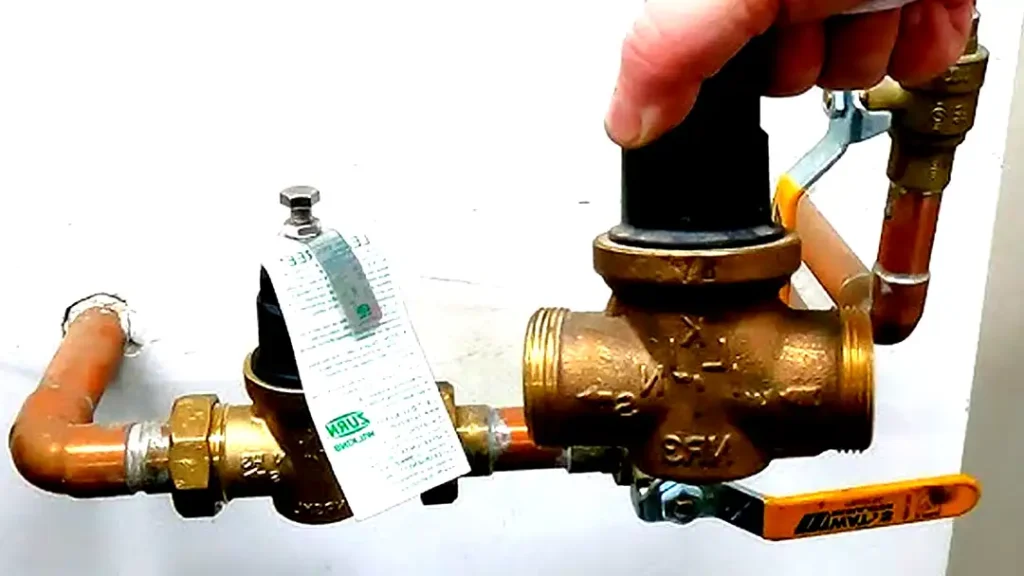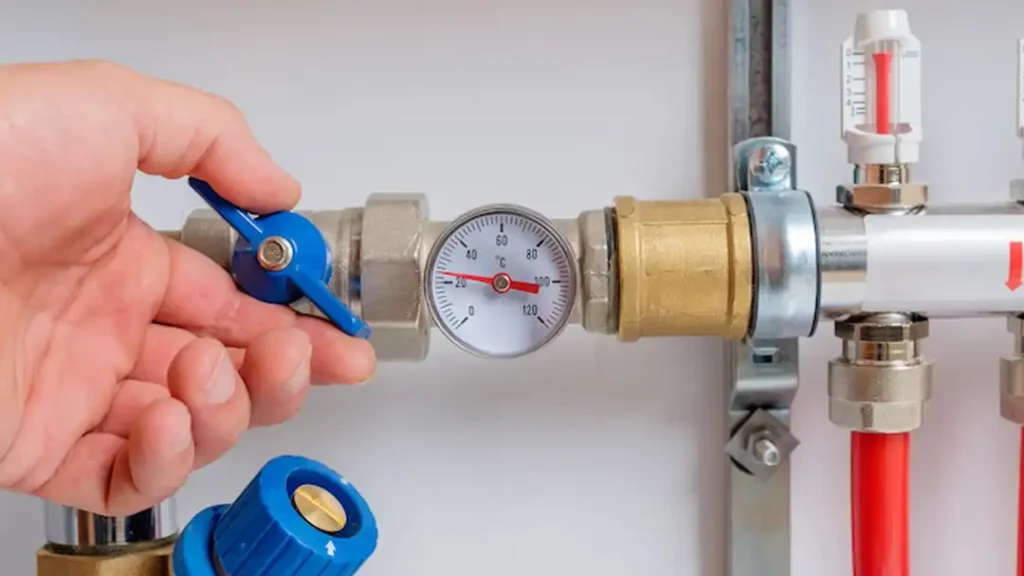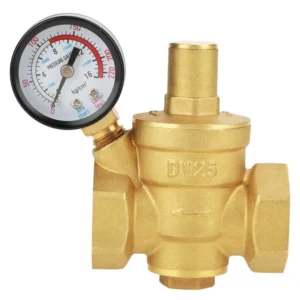Water pressure regulators are crucial in maintaining optimal water flow and pressure within a plumbing system. However, when these regulators malfunction or encounter issues, they can produce disruptive noises that can be annoying and concerning for homeowners.
In this comprehensive guide, we’ll dive into the causes, symptoms, diagnosis, and solutions for water pressure regulator noise, helping you address this common plumbing issue effectively.
What is Water Pressure Regulator

A water pressure regulator is a plumbing device designed to control and maintain the water pressure within a plumbing system. It serves as a barrier between the municipal water supply or well pump and the internal plumbing of a home or building.
The primary function of a water pressure regulator is to reduce the incoming water pressure to a safe and consistent level, ensuring that it doesn’t exceed the capacity of the pipes, fixtures, and appliances within the property.
Types of Water Pressure Regulator

There are several types of water pressure regulators available, each designed to suit different plumbing systems and applications.
Here are some common types:
Single-Stage Water Pressure Regulator:
Description: This type of regulator operates using a single valve mechanism to reduce incoming water pressure to a predetermined level.
Suitability: Ideal for residential homes and small commercial properties with relatively consistent water pressure requirements.
Dual-Stage Water Pressure Regulator:
Description: Dual-stage regulators feature two separate valve mechanisms for more precise pressure control. They can handle fluctuations in water pressure more effectively.
Suitability: Recommended for properties with fluctuating water pressure or those requiring precise pressure adjustment, such as large residential complexes or industrial facilities.
Adjustable Water Pressure Regulator:
Description: Adjustable regulators allow users to manually adjust the desired water pressure setting using a screw or knob. They offer flexibility in fine-tuning the pressure to meet specific needs.
Suitability: Suitable for properties where water pressure requirements may vary, or for users who prefer customized pressure settings.
Preset Water Pressure Regulator:
Description: Preset regulators come with a fixed pressure setting that cannot be adjusted by the user. They offer simplicity and reliability, with no need for manual adjustments.
Suitability: Commonly used in residential applications where a consistent water pressure level is sufficient, and no customization is needed.
Brass Water Pressure Regulator:
Description: Brass regulators are constructed from durable brass materials, offering superior corrosion resistance and longevity compared to other materials.
Suitability: Recommended for properties with corrosive water conditions or those requiring long-term durability.
Stainless Steel Water Pressure Regulator:
Description: Stainless steel regulators are highly resistant to corrosion and chemical damage, making them suitable for harsh environments or industrial applications.
Suitability: Ideal for properties with aggressive water conditions or where hygiene and sanitation are paramount.
Compact Water Pressure Regulator:
Description: Compact regulators are designed for space-constrained installations, featuring a smaller footprint without compromising performance.
Suitability: Suitable for installations where space is limited, such as in tight plumbing enclosures or RVs.
High-Flow Water Pressure Regulator:
Description: High-flow regulators are capable of handling larger volumes of water flow without sacrificing pressure control. They are suitable for properties with high-demand water usage.
Suitability: Recommended for properties with multiple bathrooms, irrigation systems, or commercial applications where high water flow rates are common.
Understanding the different types of water pressure regulators allows homeowners and property managers to select the most suitable option based on their specific requirements and preferences.
Why Do Water Pressure Regulators Make Noise

Water pressure regulators can make noise due to various reasons, ranging from mechanical issues to hydraulic phenomena within the plumbing system. Here are some common reasons why water pressure regulators produce noise:
Sediment Buildup: Over time, mineral deposits and debris can accumulate within the regulator or the plumbing system, leading to restricted water flow and turbulent flow patterns. This can cause vibrations and rattling noises as water passes through the regulator.
Faulty Internal Components: Worn-out or damaged internal components such as the diaphragm, springs, or seals can affect the regulator’s ability to function properly. As a result, the regulator may produce unusual sounds such as humming, whistling, or clicking.
Water Hammer Effect: The water hammer effect occurs when the flow of water is suddenly halted or redirected, causing hydraulic shock waves to travel through the plumbing system. This can result in loud banging or hammering noises, especially when faucets or valves are closed rapidly.
High Water Pressure: Excessively high water pressure entering the regulator can put strain on the valve mechanism, causing it to vibrate or oscillate. This can manifest as humming or buzzing noises as the regulator attempts to maintain the desired pressure level.
Improper Installation: Incorrect positioning or sizing of the water pressure regulator during installation can lead to operational issues and noise problems. If the regulator is not securely fastened or aligned with the water flow, it may produce rattling or shaking noises.
Air Chamber Issues: Air chambers or shock absorbers installed in the plumbing system help mitigate the water hammer effect by providing a cushion of air to absorb pressure fluctuations. If these air chambers become waterlogged or lose their effectiveness, it can contribute to noisy plumbing.
Corrosion and Rust: Corrosion and rust within the plumbing system can cause friction and turbulence as water flows through the pipes and regulator. This can result in squealing or squeaking noises as metal surfaces rub against each other.
Inadequate Maintenance: Lack of regular maintenance and upkeep of the plumbing system can exacerbate noise problems associated with water pressure regulators. Routine flushing, cleaning, and inspection are essential to prevent sediment buildup and component deterioration.
By addressing the underlying causes of water pressure regulator noise, homeowners can restore peace and quiet to their plumbing systems while ensuring optimal performance and longevity. Regular maintenance, timely repairs, and professional inspections can help identify and resolve noise issues before they escalate into major problems.
Moaning Noises From a Water Pressure Regulator
Moaning noises from a water pressure regulator can be unsettling and indicate underlying issues within the plumbing system.
Here are some possible reasons why a water pressure regulator might produce moaning noises:
- Sediment Accumulation: If sediment or debris has built up inside the water pressure regulator or the pipes connected to it, it can disrupt the flow of water and lead to turbulent conditions. This turbulence can cause the regulator to emit moaning or groaning sounds as water passes through.
- Restricted Water Flow: A partial blockage or restriction in the water supply line can create irregular flow patterns, resulting in pressure fluctuations and noise. The water pressure regulator may moan as it struggles to maintain a steady flow despite the obstruction.
- Faulty Diaphragm: The diaphragm inside the water pressure regulator is responsible for regulating water flow and pressure. If the diaphragm is damaged, worn out, or improperly seated, it may vibrate or flutter, producing moaning noises in the process.
- High Water Pressure: Excessive water pressure entering the regulator can overload its capacity and cause it to operate under strain. The moaning noises could indicate that the regulator is struggling to manage the elevated pressure levels effectively.
- Air in the System: Air trapped within the plumbing system can create pockets of turbulence when water flows through, leading to noise issues. Bleeding air from the system or ensuring proper air chamber installation can help alleviate this problem.
- Corrosion or Wear: Corrosion or wear on internal components of the water pressure regulator, such as springs or seals, can compromise its functionality and result in noise generation. Moaning noises may be a sign of deteriorating parts needing replacement.
- Temperature Fluctuations: Drastic temperature changes in the water supply can cause expansion and contraction of pipes, fittings, and regulator components. These thermal fluctuations can induce stress on the regulator, leading to moaning sounds.
- Hydraulic Shock: Rapid changes in water flow or pressure, known as hydraulic shock or water hammer, can occur when valves are suddenly opened or closed. The resulting shock waves can reverberate through the plumbing system, causing moaning noises from the regulator.
Addressing moaning noises from a water pressure regulator often requires diagnosing the underlying cause and taking appropriate corrective action. Consulting a licensed plumber to inspect the system thoroughly can help identify and resolve the issue effectively. Regular maintenance and proactive measures can also prevent moaning noises and ensure the smooth operation of the plumbing system.
How to Identify a Bad Water Pressure Regulator

Identifying a faulty water pressure regulator is crucial for maintaining a properly functioning plumbing system.
Here are several indicators that may help you identify a bad water pressure regulator:
Inconsistent Water Pressure: One of the most common signs of a faulty water pressure regulator is inconsistent water pressure throughout your home. If you notice sudden changes in water pressure, such as sporadic surges or drops, it may indicate a malfunctioning regulator.
High Water Pressure: Excessively high water pressure can put undue stress on your plumbing fixtures, pipes, and appliances, leading to leaks, bursts, and premature wear. If you measure water pressure exceeding the recommended range (typically 40-80 psi for residential systems), it may be a sign of a faulty pressure regulator allowing too much pressure to pass through.
Low Water Pressure: On the other hand, consistently low water pressure throughout your home could also be a sign of a bad water pressure regulator. A regulator that fails to maintain adequate pressure levels may restrict water flow, resulting in diminished water pressure at faucets, showers, and appliances.
Water Hammering: Water hammering occurs when hydraulic shock waves reverberate through the plumbing system due to sudden changes in water flow or pressure. A malfunctioning pressure regulator may contribute to water hammering by failing to regulate pressure effectively, resulting in loud banging or hammering noises when faucets are turned on or off.
Visible Leaks or Damage: Inspect your plumbing system for any visible signs of leaks, corrosion, or damage around the pressure regulator or adjacent pipes. Leaks or moisture accumulation may indicate a compromised regulator or deteriorating components that require attention.
Unusual Sounds: Listen for any unusual sounds emanating from the pressure regulator, such as humming, whistling, or clicking noises. These sounds may indicate internal components experiencing wear, improper adjustment, or malfunction.
Pressure Gauge Readings: Use a pressure gauge to measure the water pressure at various fixtures throughout your home. If the pressure readings fluctuate significantly or exceed the recommended range, it could indicate a problem with the pressure regulator.
Poor Performance of Appliances: Appliances such as washing machines, dishwashers, and water heaters rely on consistent water pressure to operate efficiently. If these appliances experience performance issues, such as slow filling times or incomplete cycles, it may be due to inadequate pressure regulation.
Regular Maintenance Concerns: If you’ve recently experienced plumbing issues or have not maintained your plumbing system regularly, it’s advisable to inspect the pressure regulator for signs of wear, corrosion, or deterioration. Routine maintenance can help identify and address potential problems before they escalate.
If you observe any of these signs indicating a bad water pressure regulator, it’s essential to address the issue promptly to prevent further damage to your plumbing system and property. Consult a licensed plumber for a thorough inspection and proper diagnosis, followed by appropriate repairs or replacements as needed. Regular maintenance and monitoring of your pressure regulator can help ensure the long-term integrity and performance of your plumbing system.
Causes and Risk Factors
Understanding the underlying causes of water pressure regulator noise is crucial for effective troubleshooting. Several factors can contribute to this issue, including:
Sediment Accumulation:
- Description: Buildup of mineral deposits and debris within the regulator or pipes.
- Risk Factors: Hard water supply, lack of regular maintenance, aging plumbing system.
Faulty Installation:
- Description: Incorrect positioning or sizing of the water pressure regulator during installation.
- Risk Factors: DIY installation without proper knowledge or experience, use of incompatible components.
Worn-Out Components:
- Description: Degradation or damage to internal parts such as the diaphragm, springs, or seals.
- Risk Factors: Aging regulator, excessive water pressure, frequent usage.
Water Hammer Effect:
- Description: Hydraulic shock waves generated by sudden changes in water flow or pressure.
- Risk Factors: Rapid closing of faucets or valves, improper air chamber maintenance.
Diagnosis and Tests
Diagnosing water pressure regulator noise often involves a systematic assessment of the plumbing system and regulator functionality. Here are some diagnostic tests and tools commonly used:
Pressure Gauge Test:
- Procedure: Attaching a pressure gauge to a faucet and monitoring pressure fluctuations.
- Purpose: Determine if the regulator is maintaining consistent pressure levels.
Visual Inspection:
- Procedure: Examining the regulator for signs of leaks, corrosion, or physical damage.
- Purpose: Identify visible issues that may be contributing to the noise.
Flow Rate Analysis:
- Procedure: Measuring water flow rates at various fixtures throughout the house.
- Purpose: Assess the impact of restricted flow on water pressure and noise levels.
Internal Component Check:
- Procedure: Disassembling the regulator to inspect internal components such as the diaphragm and springs.
- Purpose: Identify worn-out or damaged parts requiring replacement.
Treatment Options
Addressing water pressure regulator noise may require a combination of preventive measures and targeted interventions.
Here are some treatment options to consider:
Sediment Flushing:
Procedure: Flushing the plumbing system to remove accumulated sediment and debris.
Benefits: Restores optimal water flow and reduces the risk of pressure fluctuations.
Regulator Adjustment:
Procedure: Adjusting the regulator settings to achieve the desired water pressure.
Benefits: Optimizes regulator performance and minimizes noise levels.
Component Replacement:
Procedure: Replacing worn-out or damaged internal components such as the diaphragm or springs.
Benefits: Restores regulator functionality and eliminates noise issues.
Hydraulic Shock Arrestor Installation:
Procedure: Installing shock arrestors or water hammer arrestors to absorb pressure surges.
Preventive Measures
Preventing water pressure regulator noise involves regular maintenance and proactive measures to preserve the integrity of the plumbing system. Here are some preventive tips to follow:
Regular Flushing:
Frequency: Perform flushing of the plumbing system annually to remove sediment buildup.
Procedure: Open all faucets and flush the system with clean water for several minutes.
Pressure Monitoring:
Frequency: Check water pressure regularly using a pressure gauge.
Threshold: Maintain pressure levels within the recommended range to prevent regulator strain.
Professional Inspection:
Frequency: Schedule periodic inspections by a licensed plumber.
Purpose: Identify and address potential issues before they escalate into major problems.
Timely Repairs:
Promptness: Address any leaks, drips, or unusual noises promptly to prevent further damage.
Professional Assistance: Seek professional assistance for complex repairs or replacements.
Conclusion
In conclusion, water pressure regulator noise can be a nuisance for homeowners, but it is a manageable issue with the right approach. By understanding the causes, symptoms, diagnosis, and treatment options outlined in this guide, you can effectively address this common plumbing concern. Remember to prioritize preventive measures and seek professional assistance for complex issues to ensure the long-term health of your plumbing system.

